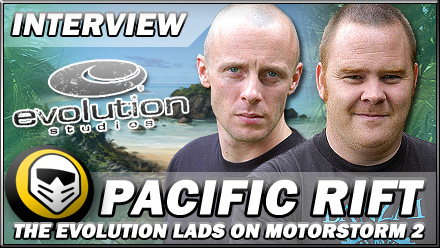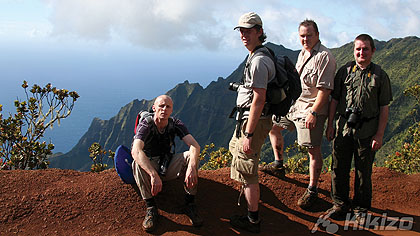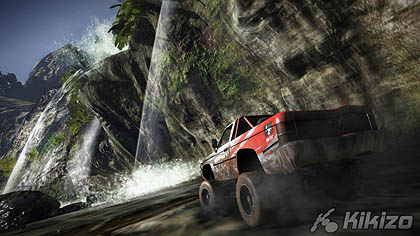MotorStorm 2: Evolution Studios Interview
We chat with Evolution boys Paul Hollywood and Nigel Kershaw to get the full picture on MotorStorm Pacific Rift.

They don't come much bigger, throatier and muddier than MotorStorm Pacific Rift, the Hawaiian follow-up to one of the PlayStation 3's centrefold launch titles. It's a little under three weeks till Evolution Studios' tropical tearaway makes its debut, and we can already smell the scorching wildlife.
If you've been paying attention, you'll know that our preview build left us in fits of auto-destructive ecstasy: the PS3 may be shedding third party exclusives faster than it can render an on-screen blob, but its fistful of first or second party projects looks star-studded indeed - and MotorStorm's right at the front.
It's all thanks to honest, hard-working northerners like Creative Director Paul Hollywood and Game Director Nigel Kershaw. Read on, dear gamer, for their staggeringly detailed thoughts on the illusion of speed, learning from experience and AI that "really bongs you."
Kikizo: We gave MotorStorm 1 an excellent 8.5 out of 10. How are you going to get a 10/10 this time round?
Kershaw: MotorStorm was really good as a launch title because we focussed on Monument Valley, which [allowed us] to get things really detailed and really accurate - but at the end of the day it was a brown desert. So one of the key things we wanted to do with MotorStorm Pacific Rift was to get a much wider variety - still keep it in one sort of location so that we get a sense of place and stuff, but really kind of set it somewhere we could get the lava and the fire and the mountain tops, the deserts, the jungles, the beaches. So there's a much, much wider variety of track and also a much, much wider variety of gameplay.
Hollywood: We haven't changed the core of MotorStorm 1 - we've taken that real off-road experience and transplanted it into a new location. Monument Valley was a great backdrop for MotorStorm 1 but the environment was plastic - the chaos came from the vehicles. Pacific Island fights back.
All the handling models you have in MotorStorm Pacific Rift are all very, very correct, almost like a simulation. We did a lot of work in the World Rally Championship games with the driving models. This is all under the hood, it's all latent, so you don't notice that it's a pure simulation - it's wrapped up in an arcade racing game.
Kikizo: Any specific criticisms you wanted to address?
Kershaw: There was a lot of criticism of the first title because it was quite lean. We accept the fact that it was lean and that there were other flaws - loading times and things like that - and what we've tried to do is address those issues: fatten it out, give it more longevity, more things to do, more play modes, more breadth of experience, more vehicles, more tracks - and still capture the fun that MotorStorm was always about.
One of the big things we're really, really keen on is split-screen mode. It's a really ace way of experiencing MotorStorm - in fact it's probably one of the most popular ways of playing at the office. Online play is great. Two years ago, everyone thought online play was the future - and it is, a lot of people do play online - but across the industry as a whole, people spent their time developing online modes at the expense of creating a social multiplayer experience. So what we've tried to do is put a lot more effort into giving it a really good, solid multiplayer. And it's still looking beautiful as well. The good news is that because it's our second generation PS3 title, we've not really compromised on the rendering quality to do split screen.
Kikizo: Obviously with all the new track furniture, destructibility and so forth there's quite a lot of activity on-screen. What sort of technical challenges have you faced, and how have you overcome them?
Hollywood: We improve our technology constantly. I'll tell you a story - when we worked on World Rally Championship we finished the game, and we were like 'we've learned so much, we'll throw everything away and start again.' We built WRC 2 - we learned so much more, and we threw all that away and started from scratch on WRC 3. So we're always constantly striving for perfection, and when you have a fixed technology platform like a console - PlayStation 2, PlayStation 3 - you've got to keep exploring different avenues. We've already found another 50% performance just by doing things a bit differently.
So we're on this learning curve - and PlayStation 3 definitely has a learning curve - but once you start understanding it, it's such a powerful machine. We're going to keep getting more and more and more out of it.
Kikizo: Some people say the first game was a bit slow, did you want to make it faster this time?
Kershaw: We thought about it for a while, but it just makes it so hard to play. It's not Burnout - there's a lot of off-roading, a lot of stuff to think about, there's a lot of route choice involved, things like that. And I think the sense of speed is really good, I think it works really well, and I think in some ways people have... It's not WipEout, it's not hurtling along at a thousand miles an hour, because you really have to think about the terrain you're driving over, and the things you're driving through.
Hollywood: One of the things about speed is that it's all an illusion of things moving past you. Now the Monument Valley tracks were quite barren, there weren't as many objects going past you - the speed of the vehicles in Pacific Rift is the same, but there's a lot more going on in the tracks. We have crafted some field of view and motion blur effects too.
Kershaw: Yeah, that's the thing - they were going at about a hundred miles per hour, but it's that perception of speed, how much field of view you've got on the camera, how low the camera is, all those little things contribute...












 Satoru Iwata Video Interview - the late Nintendo president spoke with Kikizo in 2004 as 'Nintendo Revolution' loomed.
Satoru Iwata Video Interview - the late Nintendo president spoke with Kikizo in 2004 as 'Nintendo Revolution' loomed. Kaz Hirai Video Interview - the first of Kikizo's interviews with the man who went on to become global head of Sony.
Kaz Hirai Video Interview - the first of Kikizo's interviews with the man who went on to become global head of Sony. Ed Fries Video Interview - one of Xbox's founders discusses an epic journey from Excel to Xbox.
Ed Fries Video Interview - one of Xbox's founders discusses an epic journey from Excel to Xbox. Yu Suzuki, the Kikizo Interview - we spend time with one of gaming's most revered creators.
Yu Suzuki, the Kikizo Interview - we spend time with one of gaming's most revered creators. Tetris - The Making of an Icon: Alexey Pajitnov and Henk Rogers reveal the fascinating story behind Tetris
Tetris - The Making of an Icon: Alexey Pajitnov and Henk Rogers reveal the fascinating story behind Tetris Rare founders, Chris and Tim Stamper - their only interview? Genuinely 'rare' sit down with founders of the legendary studio.
Rare founders, Chris and Tim Stamper - their only interview? Genuinely 'rare' sit down with founders of the legendary studio. The History of First-Person Shooters - a retrospective, from Maze War to Modern Warfare
The History of First-Person Shooters - a retrospective, from Maze War to Modern Warfare